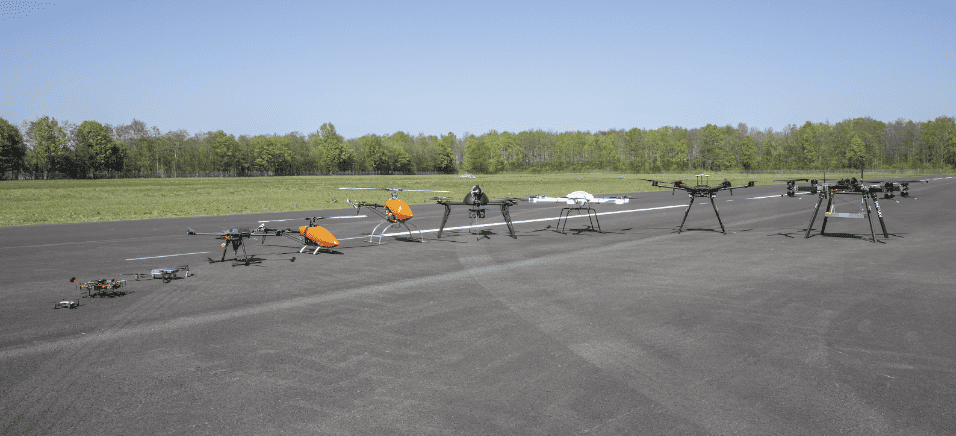
Drones are beginning to have a bigger impact on our society and economy. Developments are going fast, but many questions arise. What is the added value of drones, nationally and internationally? What are the challenges? Besides the technical capabilities, it is also important to consider regulations, commercial opportunities, and environmental impact.
The Netherlands Aerospace Center (NLR) plays a vital role in conducting research and turning knowledge into value. NLR does this through nine strategic programmes. For the series “The Aviation of the Future,” Innovation Origins speaks with all programme leaders.
For the fifth episode, we spoke with Joost Vreeken (programme leader of Unmanned and Autonomous) about the impact of aviation on society and the environment.
What exactly is the Unmanned and Autonomous knowledge programme?
“The development of drones for various applications is moving fast. Drones were barely available about five years ago, but today they’re useful tools in a range of sectors. Drones can play an important role in the future in different parts of the economy and society. At NLR, we’re investigating things like the use of unmanned and autonomous drones. We want to find solutions for the social challenges that come with using them. One example might be safely integrating drones into the airspace, or perhaps protection against undesirable drones. We also want to make sure that Dutch players can utilise the commercial opportunities this creates, both nationally and internationally.”
“An important part of that is Innovative Air Mobility. This is a form of aviation with new types of aircraft, both manned and unmanned. We want to test various initiatives, such as drone operations in the city and passenger travel. That’s not only about technological possibilities and limitations but also about other factors such as noise nuisance or logistical aspects. One good example is the added value of transport drones in less accessible areas, for instance for medical items. On the other hand, we think that passenger transport by air in Dutch cities, for example, has little to no added value compared to the existing transport network. Though it could perhaps be a nice addition for bringing people in from surrounding areas to the city.”
About the programme leader
Joost Vreeken is a R&D engineer who leads the Unmanned and Autonomous programme at NLR.
“Why do I like this work so much? Because I’m always working on new things in aviation. Especially when drones are involved, there is still so much scope for discovering and developing new things. In the large manned aircraft sector, R&D is very compartmentalised: you’re always focused on one specific part. When it comes to drones – a relatively new area of research – you soon run into all sorts of aspects. That’s why I think it’s so interesting!”
Supporting and improving
“Drones could be very good at helping city authorities with crowd control, such as monitoring traffic flows and clashes within large crowds. A drone gets an overview from above and the information from the drone can help security forces take more targeted action. That all benefits the traffic flows and safety as a whole.”
Impact on the environment
“The presence of drones in a city does inevitably have an impact, on both the drones and the city. The wind has a different effect between buildings than in open areas. That’s why we are testing extensively with drones in a scaled-down city, where we can measure not just the influence of the city on the drone, but how the drone affects the city. We look at the noise nuisance for residents, for example. We also found that it is very important for people to know why a drone is flying over. People are often afraid that they are being spied on by a drone. That’s not a nice feeling, of course. But if they know the drone is flying over to inspect a building or monitor a fire, it’s a whole different story.”
Safe airspace integration
“Within this programme we also look a the airspace integration. We investigate how unmanned aircraft can fly safely and responsibly in all sorts of airspaces, from relatively low above the ground to high in the sky. We collaborate a lot with the Safe And Competitive Operations programme for this. For example, we’re looking at the radar systems needed for detecting and avoiding other objects in the air. That’s an important point for both civil and military applications.”
From a small testing area, we will take steps towards autonomous operation in daily practice
Joost Vreeken
Why is it important that NLR is working on this?
“A lot is happening in unmanned and autonomous flight. NLR is a knowledge partner, helping governmental organisations and businesses in three areas. Firstly, we look at the conceptual side of the developments. We formulate a vision of a particular development. Additionally, we also create test environments and provide support in testing. At NLR, we have a chunk of airspace where we can run tests with drones. We do testing for our own research there, but other organisations can also use it. It is connected to our Drone Centre, which also has a workshop and office space. At NLR, we also have the space to genuinely work on the technology and test the procedures critically and independently.”
Nursery
“You can think of the research on unmanned drones as the nursery for unmanned aviation. We can test things such as flying on hydrogen at a small scale using drones and then scale it up to large unmanned aircraft. That goes not only for technical developments but also for the policies associated with them.”

Commercial opportunities
“We’re also looking at how to utilise the commercial opportunities. For instance, we’re investigating how we can get unmanned aircraft and unmanned drones to work together. We create a lot of testing opportunities for new drones and uses of drones. When a product or development is ready for the market, commercial companies take over the development and NLR takes a step back.”
“Another important part of this is CNS: communication, navigation and surveillance. We make sure that the drone can use the latest satellite navigation system, for example. Additionally, we look at the certification of new, unmanned aircraft. All of this is new, so completely new frameworks and guidelines have to be created, not only in the Netherlands but also in the European context.”
The future of drones is autonomous
“In the future, I envisage fully autonomous drones. We’ve got a long way to go to make that a reality; at the moment, drone flight is highly automated but not fully autonomous. Today we’re working on further optimisation of ‘visual line-of-sight’ operations, which means that the drone must always stay where the pilot can see it. We’re also working on making these flights quieter and more efficient, including in situations with poor weather. Flying beyond the visual line of sight of the pilot is the next step. This is currently undergoing initial testing. For example, the fire brigade in the east of the country is testing whether they can send drones ahead to the location of a fire alarm. The ultimate goal is for the emergency services to have drones posted everywhere that can collect information before the red, white and blue arrive. We expect it will be possible to do these types of flights at a large scale by around 2030.”
“The next step is that drones can cooperate with manned aviation on a daily basis. This can be used for inspections in search-and-rescue activities. Using drones, it is possible to work with larger search areas. Drone swarms are another aspect of this as well. That’s the term for a large group of individual drones that perform a task together.”
“The final step is a fully autonomous drone, one that has become so smart that it can safely decide for itself what to do at a certain time, without human input. So if a drone is going to inspect wind turbines at sea, it decides for itself which part it needs to inspect, when it needs to go back to the charging station and what other actions must be taken. This should make operations many times more efficient and it is essential if the full potential of unmanned aviation is to be realised. I expect that to be possible by around 2040. We’ll have to get cracking on it now, though. That’s why we want to start initial testing with drones that are truly autonomous next year. From a small testing area, we will take steps towards autonomous operation in daily practice.”

